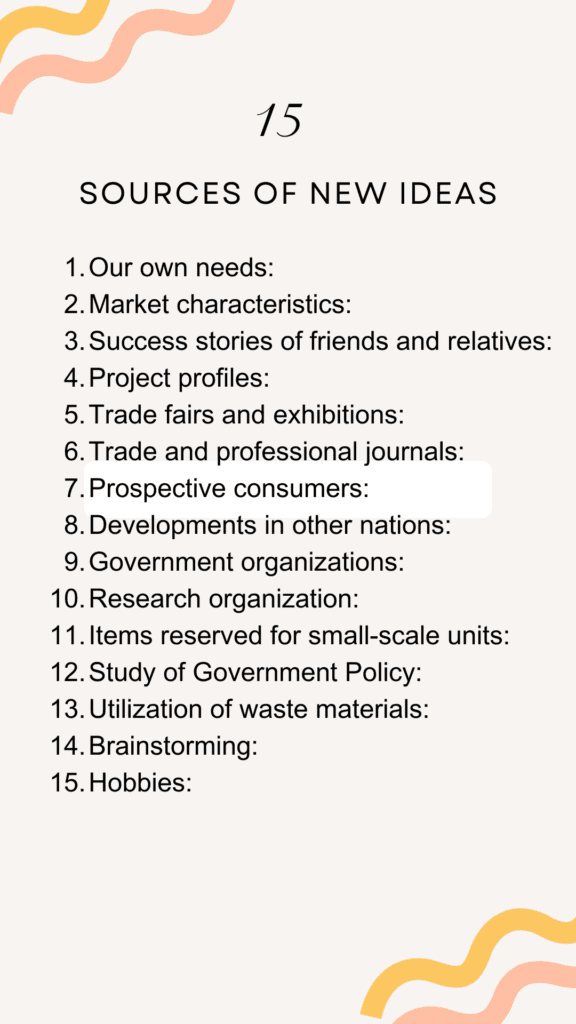When it comes to Sources of new ideas, there are various avenues to explore. From observing the world around us to engaging in brainstorming sessions with others, the sources of innovative ideas are plentiful and diverse.
By tapping into our creativity and curiosity, we can uncover innovative solutions and concepts that have the potential to shape the future.
Whether it’s through reading books, attending workshops, or simply taking a walk in nature, inspiration can strike from unexpected places, leading to exciting breakthroughs and advancements in various fields.
15 Innovative Sources of New Ideas in Entrepreneurship

The business concept comes from a chance in the market. It originates from any need or wants for any product or service that an entrepreneur can identify. Entrepreneurs should have an open mind to look for opportunities and generate business ideas.
Thomas J. Watson a keen says, “Opportunity never knocks on the door. You need to seize the chance and opportunities are everywhere.
Thomas J. Watson
The entrepreneur is always on the lookout for opportunities and has a keen sense of which ones to pursue. It’s not about analyzing every detail, but rather trusting their instincts.
Here are a few examples of Sources of new ideas in entrepreneurship:
1. Our own needs:
Our own needs often provide the business opportunity. In 1984, Tom Hunter was an unemployed graduate in marketing and economics living in Ayrshire, Scotland. He enjoyed wearing sneakers and realized that there weren’t any stores nearby with a great variety. “I saw that more people wanted sneakers. I thought maybe I could start a business selling them.”.
He borrowed money from his father and the bank to buy stock and rented space from a retail group that had stores in Aberdeen, Leeds, and Sunderland. Soon he had 50 such outlets. He then set up his shops; by 1995 he had 45 annual sales of 36 million pounds.
2. Market characteristics:
Paying close attention to markets can help uncover a potential business concept. Observing is a key way to come up with ideas for projects. Surveys of the market can also show the current demand and supply for different products.
It’s important to predict future demand by considering possible shifts in trends, income, technology, and more. It’s helpful to determine if the demand is high or low. Analyzing the price trends of different products can provide insight into how demand and price are related.
Further, attempts should be made to determine the trend of demand and the composition and pattern of potential users of the product. The success of Kellogg’s breakfast as a quick and nutritious food is an example of the success of the new idea.
3. Success stories of friends and relatives:
A person may meet people who are successful in their ventures. Their success stories may inspire others. This inspiration/motive may drive them to start a venture or take up projects.
4. Project profiles:
Different government and private organizations release regular reports on different projects and industries. These reports provide detailed information on technical, financial, and market needs. Reviewing these reports carefully can assist in deciding on a business direction.
5. Trade fairs and exhibitions:
Trade fairs and exhibitions are set up by the Industries Department of both the Central and State Governments, as well as various Trade Organisations. These events serve as an excellent platform for generating business ideas. During these fairs, a wide range of products are showcased and sold. Exploring these fairs allows individuals to stay updated on the latest products and machines available in the market.
6. Trade and professional journals:
Trade and professional journals/magazines are also sources of ideas. These magazines and journals offer information about products produced or parts needed by other manufacturing plants.
7. Prospective consumers:
Businesses rely on consumers as the cornerstone of their success. It is the consumer who keeps a business going. Therefore, an entrepreneur needs to contact prospective consumers. The entrepreneur should conduct an analysis of the product and its market from the point of view of the customers. The data on consumer preferences and needs will have to be collected. This enables the entrepreneurs to manufacture products according to the customer’s satisfaction.
8. Developments in other nations:
People in less developed countries often look to more advanced countries for fashion inspiration. By staying updated on trends in these advanced countries, one can come up with innovative business ideas. Occasionally, individuals even travel abroad to seek out fresh ideas for new products or processes.
9. Government organisations:
Various government organizations and agencies support entrepreneurs by assisting them in exploring and assessing business concepts. Development banks, state industrial corporations, technical consultancy organizations, investment centers, export promotion councils, district industrial centers, and more offer guidance and aid in technical, financial, marketing, and other aspects of business.
10. Research organisation:
Study of new products/processes developed by research laboratories etc., gives project ideas to prospective entrepreneurs.
11. Items reserved for small-scale units:
The list of industries reserved exclusively for the development of small-scale sectors will also indicate the potential available.
12. Study of Government policy:
The study of Government policies regarding industrialization, exports, imports, development of backward areas, etc., provides a source of business ideas.
13. Utilisation of waste materials:
Industries can be established to utilize the waste products of some industries. Similarly, ancillaries may be set up to supply components to large units.
14. Brainstorming:
Brainstorming is a creative group problem-solving technique that involves generating a large number of fresh ideas. Under brainstorming a group of persons sit together and generate as many project/business ideas as possible. One idea leads to another. Brainstorming was first developed by Alex F. Osborn in 1941 and gained acceptance by the business world in 1950.
15. Hobbies:
Some individuals have a keen interest in pursuing various hobbies or acquiring skills solely meant for personal use at home. Interestingly, these skills can also be utilized to establish a business venture. Hobbies like photography, interior decoration fashion designing, etc. are often developed as ventures.
Conclusion
In conclusion, the sources of new ideas are diverse and plentiful. One significant source is personal experiences and observations. By actively engaging with the world around us, we can gain unique insights and perspectives that can spark innovative ideas.
Another important source is collaboration and communication with others. Through brainstorming sessions, discussions, and sharing ideas, we can tap into the collective knowledge and creativity of a group, leading to the generation of fresh concepts.
Additionally, research and exploration play a crucial role in discovering new ideas. By delving into existing knowledge, studying different fields, and staying curious, we can uncover hidden connections and possibilities that can inspire innovative thinking.
Lastly, embracing change and being open to new experiences can also serve as a source of new ideas. By stepping out of our comfort zones and embracing new perspectives, we can challenge conventional thinking and discover novel solutions.
In conclusion, the sources of new ideas are vast and varied, and by actively engaging with these sources, we can foster a culture of innovation and creativity.











I used to be very pleased to search out this internet-site.I wanted to thanks on your time for this excellent read!! I positively having fun with each little little bit of it and I have you bookmarked to take a look at new stuff you blog post.
Thanks 🙏🙏
hello!,I like your writing so much! share we communicate more about your post on AOL? I need an expert on this area to solve my problem. Maybe that’s you! Looking forward to see you.
I do it
We stumbled over here from a different website and thought I might as well check things out. I like what I see so now i am following you. Look forward to going over your web page yet again.
Thanks for your cooperation
hey there and thank you for your info ?I have certainly picked up something new from right here. I did however expertise several technical points using this web site, as I experienced to reload the web site a lot of times previous to I could get it to load correctly. I had been wondering if your web hosting is OK? Not that I’m complaining, but sluggish loading instances times will sometimes affect your placement in google and could damage your high-quality score if ads and marketing with Adwords. Anyway I am adding this RSS to my e-mail and can look out for much more of your respective intriguing content. Ensure that you update this again very soon..
Hi there! 😊 Thanks so much for your thoughtful comment! I’m glad to hear you found something new here. I appreciate you pointing out the technical issues you experienced with the website loading. We’re always looking to improve, and your feedback is really helpful. We’re currently reviewing our hosting situation to ensure everything runs smoothly.
It’s great to know you’re adding our RSS feed to your email! We’ll definitely keep the content coming, so stay tuned for more updates. Thanks again for your support, and have a fantastic day! 🌟